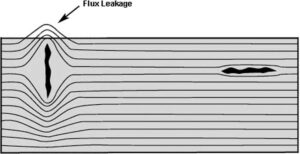Magnetic Field Orientation and Flaw Detectability
To effectively examine a component for cracks or defects, it’s crucial to recognize that the alignment between the magnetic lines of force and the flaw holds great significance. Two primary categories of magnetic fields can be established within a component.
The first is a longitudinal magnetic field, characterized by magnetic lines of force aligning parallel to the part’s long axis. Achieving longitudinal magnetization within a component can be accomplished through the use of a coil or solenoid to establish the longitudinal field. Alternatively, it can be achieved by employing permanent magnets or electromagnets.
The second type is a circular magnetic field, where magnetic lines of force encompass the part’s perimeter in a circumferential manner. Inducing a circular magnetic field within an object can be achieved by either passing current directly through the component or by passing current through a conductor encircled by the component.

The kind of magnetic field formed hinges on the technique employed to magnetize the specimen. The capability to magnetize the component in two directions holds significance, as optimal defect detection takes place when the magnetic lines of force are oriented perpendicular to the defect’s longest dimension. This alignment results in the most significant perturbation of the magnetic field within the component, leading to the greatest flux leakage at its surface. As depicted in the accompanying image, if the magnetic field aligns parallel to the defect, minimal disruption occurs in the field, yielding no production of a flux leakage field.

To generate an indication, an angle ranging from 45 to 90 degrees between the magnetic field and the defect is crucial. Given that defects can manifest in diverse and unpredictable orientations, it is customary to magnetize each component in two distinct directions perpendicular to one another. When considering the depicted component, applying current through it lengthwise will establish a circular magnetic field, positioned at a 90-degree angle to the current’s direction. Consequently, defects with a substantial dimension aligning with the current (longitudinal defects) should be discernible. Conversely, transverse-oriented defects will remain undetectable with circular magnetization.

